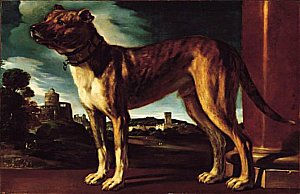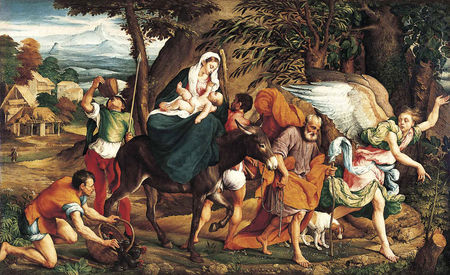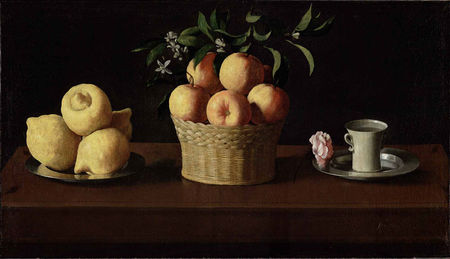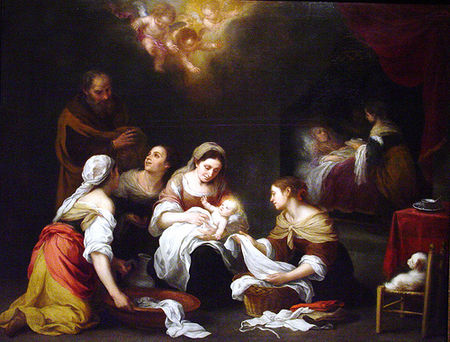Unprecedented Reciprocal Loan Collaboration Between the Frick and Norton Simon Museum
Jacopo Bassano (Jacopo da Ponte), Italian, (c. 1510–1592), The Flight into Egypt, c. 1544–45. Oil on canvas 48 ½ x 77 ¼ inches. Norton Simon Art Foundation
NEW YORK, NY.- Established decades apart and on separate coasts, New York’s Frick Collection and the Norton Simon Museum in Pasadena, CA, are both fine examples of a museum type that focuses on the viewpoint and taste of an individual founder. Henry Clay Frick was by no means the first American to create a museum for the public with his own holdings, but the 1935 opening of the institution bearing his name sparked international headlines and set an example followed subsequently by many others, including Californian Norton Simon. Indeed, exactly four decades later, Simon turned to the Frick as a model for his own institution. It is therefore fitting that the two organizations should one day become collaborators, and this winter, they inaugurate an ongoing reciprocal loan arrangement with the Frick presentation of Masterpieces of European Painting from the Norton Simon Museum. On view in New York from February 10 through May 10 in the Frick’s Oval Room will be five sixteenth- and seventeenth-century masterpieces, none of which has left its Southern California home in almost three decades. True highlights from the Norton Simon Museum, an institution that has seldom lent from its collection, the featured paintings are Jacopo Bassano’s (Jacopo da Ponte, 1510–1592) Flight into Egypt, c. 1544–45; Peter Paul Rubens’s (1577–1640) Holy Women at the Sepulchre, c. 1611–14; Guercino’s (Giovanni Francesco Barbieri, 1591–1666) Aldrovandi Dog, c. 1625; Francisco de Zurbarán’s (1598–1664) Still Life with Lemons, Oranges and a Rose, 1633; and Bartolomé Esteban Murillo’s (1617–1682) Birth of Saint John the Baptist, c. 1660.
This exhibition is very much in keeping with the Frick tradition of presenting important Old Master paintings from American institutions that are less well known to the New York public. Previous projects have focused on the collections of The Cleveland Museum of Art (Fall 2007), the Toledo Museum of Art (Fall 2002), and The Kimbell Art Museum, Fort Worth (Winter 1989/90). The New York presentation is organized by the Frick’s Associate Director and Peter Jay Sharp Chief Curator Colin B. Bailey and Carol Togneri, Chief Curator of the Norton Simon Museum, with Margaret Iacono, Assistant Curator of the Frick. It will be accompanied by a publication and a series of public programs. Principal funding for Masterpieces of European Painting from the Norton Simon Museum is provided by Melvin R. Seiden in honor of Colin B. Bailey. Major corporate support is provided by Fiduciary Trust Company International. Additional support is generously provided by the Thaw Charitable Trust and Mr. and Mrs. John P. Birkelund. This exhibition is supported by an indemnity from the Federal Council on the Arts and the Humanities.
Colin B. Bailey comments, “It was a great privilege to be able to select five unquestioned masterpieces from the sixteenth and seventeenth centuries from the collection of European paintings at the Norton Simon Museum, each one of which ranks among the artist’s finest works in any museum. More by accident than design the artists selected are not represented in the Frick’s permanent collection―yet the level of quality is absolutely consistent with the Frick’s greatest works. I am excited that the extraordinary riches of the Norton Simon Museum are being introduced to our audience in this peerless group, and delighted that we are able to reciprocate in the autumn of 2010 with a loan of Ingres’s Comtesse d’Haussonville and two related drawings from our collection.” Carol Togneri further explains, “The Frick’s absolutely iconic Ingres portrait comes to Southern California for the first time through this exchange. With a pair of preparatory drawings, it will be installed adjacent to one of our own magnificent works by the artist, the portrait of Baron Joseph-Pierre Vialetés de Mortarieu. Collaborations such as these are tremendously rewarding for all concerned, as they stimulate new ways of interpreting works of art and encourage broader awareness―in this case coast to coast―of our histories and offerings to the public.”
Norton Winfred Simon (1907–1993) was a pioneering entrepreneur whose enormous wealth derived from numerous business ventures ranging from the creation of a sheet metal distribution company and the triumphant revival of Hunt Foods, Inc., to the eventual formation of Norton Simon Inc., a multi-industry conglomerate that included Hunt-Wesson Foods, McCall’s Publishing, Max Factor cosmetics, and Avis Car Rental. Simon’s focus turned to art in the 1950s, and in the same intelligent and strategic manner employed to forge his business empire, he amassed an art collection of great renown. In creating the basis for his museum, Simon looked to Henry Clay Frick and his museum as the preeminent model for acquisitions, installations, publications, and the shaping of visitors’ experiences. Like Frick, he was a self-made entrepreneur who collected art with a passion. Also like Frick, Simon’s hard-earned fortune enabled him to buy the best works of art available on the market. Simon’s first acquisitions were Impressionist and Post-Impressionist works by such recognized masters as Degas, Renoir, Gauguin, and Cézanne. In the 1960s he began acquiring Old Masters and modern works, choosing to sell many of his acclaimed French Impressionist paintings at the decade’s close; in the 1970s Simon’s appreciation for Indian and Southeast Asian art emerged and was reflected in his burgeoning collection.
Unlike Frick, whose collection was foremost a personal one that he later decided to bequeath to the public, Simon’s collection—from its inception—was shaped with the public in mind. So concerned was Simon with the public’s assessment of the artworks he acquired that he sought the opinion of scholars, dealers, and even members of his household staff. His desire to make important works of art available to Southern California’s community led him to assume a seminal role in the establishment of the Los Angeles County Museum of Art. Additionally, Simon created two foundations, each responsible for acquiring and exhibiting art under his direction as part of his mission to engender a “museum without walls.” Chief among The Norton Simon Foundation’s acquisitions was the 1964 purchase of the remainder of Duveen Brothers’ New York inventory, a significant cache that included Old Master paintings, Italian marbles, furniture, tapestries, its library, and even the New York City townhouse in which it all was housed. Having assumed management of the financially troubled Pasadena Museum of Modern Art in the early 1970s, Simon and the museum’s trustees reached an agreement to combine Pasadena’s collection with his own, forming the Norton Simon Museum of Art. The new museum opened in 1975 and today consists of a collection of Western and Asian art spanning more than two thousand years and containing paintings, sculpture, works on paper, and photography.
A MIRACULOUS PURCHASE
In Jacopo Bassano’s majestic Flight into Egypt, Joseph flees Bethlehem with Mary and Jesus, having been warned by an angel in a dream of Herod’s call for the murder of all boys under the age of two. The artist’s representation departs significantly from the traditional account. Instead of making a nocturnal exodus through an arid landscape, Bassano’s figures escape across a sunlit, bountiful countryside, accompanied by an angel with fanciful downy wings. Absent from the biblical account, the angel is most likely the prophetic messenger of Joseph’s dream. He points toward a nascent fig branch growing from a dead stump (a sign of rebirth, alluding to the Resurrection as well as an indication of the road ahead and its promise of safety). On the far left behind the holy family, a humbly dressed man kneels to release three roosters from a basket to feed. Another figure, clothed in a green tunic, drains the last drops from a flask. Almost hidden behind the donkey and Joseph is a man depicted with the characteristic bagpipe and staff of a shepherd. The presence of these three figures—all missing from the canonical account—has led scholars to interpret The Flight into Egypt as a commentary on the pilgrimage of the soul. Simon’s purchase of the Flight was considered near miraculous by the Benedictine monks who owned it. Put up for sale with the hope of initiating a building campaign for Prinknash Abbey in Gloucester, the work was acquired by Simon in 1969 from Christie’s, London, for $655,118—almost ten times the estimated auction price.
Peter Paul Rubens, The Holy Women at the Sepulchre, Norton Simon Foundation AN ADMIRER OF RUBENS
Another biblical narrative is recounted in The Holy Women at the Sepulchre by Peter Paul Rubens. The painting depicts a group of women who have gathered at Christ’s burial place to anoint his body. They discover the tomb empty; two angels emanating a radiant light relay the news of Christ’s resurrection. Despite being one of the most familiar accounts in the New Testament, Rubens’s Easter scene is inventive and intriguing. His visitors consist of six figures whose identities are uncertain. He uses the famous Roman statue Pudicitia as his model for the figure cloaked in purple. The goddess Pudicitia personified female modesty and fidelity, revered traits in Roman society. Rubens was well versed in antique Greek and Roman culture and doubtless would have been familiar with Pudicitia’s subtext. While scholars have made cases for each of the women depicted, the Magdalene is most likely the bareheaded woman in red. In Roman society, only unwed women, such as Mary Magdalene, appeared publicly with their heads uncovered. Her vibrant crimson gown evokes the bright colors worn by Roman prostitutes, and she is barefoot, as the Magdalene is commonly depicted. Other issues surround the panel, including a lack of conclusive documentation identifying its patron(s), function, and original location. It is unlikely that these questions troubled Simon. A great admirer of Rubens, Simon already owned six works by the artist when he acquired this canvas in 1972 from the famed Czerni Collection in Vienna, which was celebrated for its extraordinary seventeenth-century paintings.
TWICE OWNED  The Aldrovandi Dog was painted by Guercino around 1625. Although the dog’s name has been lost to time, we know that Count Filippo Maria Aldrovandi (1598– 1644) owned the white and brindle mastiff because its elaborate leather collar bears the Aldrovandi coat of arms. The dog’s facial scars and white hair above the mouth suggest that he is old and has seen his share of violent encounters. A villa, bathed in golden sunlight, rises in the distance atop a grassy hill alongside other imposing structures that sweep across the lush vista. Dark clouds break on either side of the canine’s head, seemingly chased by the sun-drenched white clouds that hover over the land and surround the dog’s silhouette like a vaporous halo. Aldrovandi was born into one of the oldest noble families of Bologna and became a senator there in 1623. The count was a passionate collector of art, and his friendship with Guercino was apparently quite cordial, as the artist lived in Aldrovandi’s Bolognese palace in 1642 before moving into his own residence in 1644. Guercino also was a regular visitor to the villa where the dog’s portrait probably hung. Norton Simon considered buying the Aldrovandi Dog in partnership with the J. Paul Getty Museum before purchasing it by himself in 1980. In 1982, he returned the painting to the Zurich dealers from whom he had bought it, only to buy it back again two years later. Ever the clever businessman, he repurchased the painting for $600,000, roughly half as much as he paid for it initially. © 2008 The Norton Simon Foundation
The Aldrovandi Dog was painted by Guercino around 1625. Although the dog’s name has been lost to time, we know that Count Filippo Maria Aldrovandi (1598– 1644) owned the white and brindle mastiff because its elaborate leather collar bears the Aldrovandi coat of arms. The dog’s facial scars and white hair above the mouth suggest that he is old and has seen his share of violent encounters. A villa, bathed in golden sunlight, rises in the distance atop a grassy hill alongside other imposing structures that sweep across the lush vista. Dark clouds break on either side of the canine’s head, seemingly chased by the sun-drenched white clouds that hover over the land and surround the dog’s silhouette like a vaporous halo. Aldrovandi was born into one of the oldest noble families of Bologna and became a senator there in 1623. The count was a passionate collector of art, and his friendship with Guercino was apparently quite cordial, as the artist lived in Aldrovandi’s Bolognese palace in 1642 before moving into his own residence in 1644. Guercino also was a regular visitor to the villa where the dog’s portrait probably hung. Norton Simon considered buying the Aldrovandi Dog in partnership with the J. Paul Getty Museum before purchasing it by himself in 1980. In 1982, he returned the painting to the Zurich dealers from whom he had bought it, only to buy it back again two years later. Ever the clever businessman, he repurchased the painting for $600,000, roughly half as much as he paid for it initially. © 2008 The Norton Simon Foundation
Francisco de Zurbarán, Spanish, (1598–1664), Still Life with Lemons, Oranges and a Rose, 1633. Oil on canvas 24 ½ x 43 1/8 in. Norton Simon Foundation A MILESTONE OF STILL LIFE PAINTING
Although Francisco de Zurbarán is thought of primarily as a painter of religious narratives, his Still Life with Lemons, Oranges and a Rose is a milestone in both the artist’s oeuvre (it is his only signed and dated still life) and in the history of the genre. Against a velvety black background, three groupings of objects rest on a brown tabletop: four citrons (rather than lemons) are stacked on a lustrous silver plate; a woven blond basket, brimming with oranges, is crowned with orange blossoms; and a second silver dish displays a pink rose and a white two-handled cup containing water. An intense light coming from the viewer’s left defines the objects, inducting them into the three-dimensional world while skillfully avoiding illumination of the nebulous space behind them. This penetrating radiance cascades across the polished surface of the table, casting partial reflections of the fruit, basket, and plates. After a recent cleaning in preparation for its travel to the Frick, the objects now project more convincingly while Zurbarán’s signature and the painting’s date are more easily discernible on the table’s lower edge. Though the composition may have been designed to be a still life devoid of deeper meaning, the traditional associations of the individual objects encourage a symbolic reading: the citrons are a paschal fruit and denote faithfulness; the basket of oranges represents virginity; orange blossoms, fecundity; water, purity; and the rose is a symbol of divine love. The image has been construed as an homage to the Virgin; indeed, several of the objects depicted appear in other paintings by Zurbarán in which the Virgin is the central theme. Additionally, the structural division of the composition into three separate units might allude to the Trinity. No documentation exists, however, to confirm that these symbolic associations were intended by Zurbarán or understood as such by his contemporary audience. Moreover, x-radiographs of the painting reveal that Zurbarán originally had included a silver plate of batatas confitadas, a popular treat of candied sweet potato. This may indicate that the artist was more concerned, at least initially, with the physical qualities of the objects than with their symbolic allusions.
Zurbarán’s still life was once part of the distinguished collection of Count Alessandro Contini-Bonacossi (1878–1955), and, like all of Contini’s artworks, it was to be bequeathed to the Italian nation. Owing to complex negotiations with the count’s heirs, however, only a fraction of the legendary collection ultimately came into the possession of the Italian state, and the still life was not part of it. Simon, prompted by rumors that the Louvre was about to acquire the painting, spent an impressive $2,725,000 for it in 1972, the third highest price paid for an Old Master work at the time.
Bartolomé Esteban Murillo, Birth of Saint John the Baptist, Norton Simon Foundation STRUCK BY THE APPEAL OF MURILLO
Unlike Zurbarán’s still life, Bartolomé Esteban Murillo’s Birth of Saint John the Baptist is unambiguously religious in its theme. Murillo presents the scene with all the drama of a theatrical production. In the center foreground of the picture sits a middleaged nurse who supports the newborn child on her lap while gently drying him following his first bath. A servant girl turns toward the father, Zechariah, who gestures at his son, while in the background to the right, an exhausted Saint Elizabeth lies in bed, attended by a woman who offers her food. Two ethereal sources illuminate the scene: the saintly child, who radiates an intense brilliance, and a cluster of angels, who emit a golden glow as they peer down from the heavens at the beatific infant. Although various events from the life of Saint John the Baptist are recorded in all four of the canonical gospels, only Luke describes the circumstances of his birth. Murillo’s scene, with its depiction of the infant’s first bath, underscores the Baptist’s future vocation. Also, the brilliant, pure white of the towels can be seen as an allusion to the words of Saint John Chrysostom (c. 347–c. 407), who described John’s purity as surpassing even the whitest of garments. Murillo situates the intimate scene in a humble setting populated with figures reminiscent of those he would have encountered every day on the streets of his native city, Seville. The artist’s talent for relating the most sacrosanct of events in an ordinary language made his works widely appealing. The Birth of Saint John the Baptist was in England by the early 1800s in the collection of Henry Gally Knight (1786–1846), a poet, author, and Member of Parliament. (Before that time, the painting probably had remained in Spain.) Simon purchased it in 1973, a year after The Norton Simon Foundation had acquired Murillo’s Saint Thomas of Villanueva Giving Alms to the Poor of about 1678.

/https%3A%2F%2Fprofilepics.canalblog.com%2Fprofilepics%2F1%2F0%2F100183.jpg)
/https%3A%2F%2Fstorage.canalblog.com%2F03%2F02%2F119589%2F96711876_o.jpg)
/https%3A%2F%2Fstorage.canalblog.com%2F11%2F31%2F119589%2F94773502_o.jpg)
/https%3A%2F%2Fstorage.canalblog.com%2F20%2F83%2F119589%2F94772815_o.jpg)
/https%3A%2F%2Fstorage.canalblog.com%2F26%2F72%2F119589%2F75604929_o.jpg)
/https%3A%2F%2Fstorage.canalblog.com%2F59%2F60%2F119589%2F26458628_o.jpg)






/http%3A%2F%2Fstorage.canalblog.com%2F97%2F90%2F119589%2F109883998_o.jpg)
/http%3A%2F%2Fstorage.canalblog.com%2F13%2F38%2F119589%2F76060903_o.jpg)
/http%3A%2F%2Fstorage.canalblog.com%2F25%2F19%2F119589%2F35531248_o.jpg)
/http%3A%2F%2Fstorage.canalblog.com%2F91%2F92%2F119589%2F34354939_o.jpg)